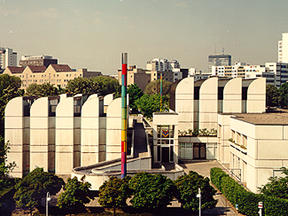Colourful!
dal 10/6/2005 al 12/9/2005
Segnalato da
10/6/2005
Colourful!
Bauhaus-Archiv, Berlin
'Gropius' and the 'Bauhaus' are typically associated with white, cubic volumes and neutral interior surfaces. This assumption is contradicted by the variety of original colours found on Bauhaus buildings in the eastern German states since 1989. The aim of the exhibition is to demonstrate the many ways in which a synthesis of colour and architecture was achieved at the Bauhaus.

The Wall Painting Workshop at the Bauhaus
Amidst the grey monotony of early twentieth-century architecture, the call for more
colour grew loud and persistent, and it was not long before the first polychrome
housing developments caused a stir in Berlin. Among the protagonists of this
movement was Walter Gropius. At the Weimar Bauhaus, which he founded in 1919,
Gropius pursued the concept of architecture as a resplendently colourful
Gesamtkunstwerk.
Today, however, 'Gropius' and the 'Bauhaus' are typically associated with white,
cubic volumes and neutral interior surfaces. This assumption is contradicted not
only by contemporary documents, but also by the astonishing variety of original
colours found on Bauhaus buildings in the eastern German states since 1989. The aim
of the exhibition 'Colourful!' is to demonstrate the many ways in which a synthesis
of colour and architecture was achieved at the Bauhaus.
In the very first years, the wall treatments at the Bauhaus were still inspired by
Expressionism. By today's standards, these are often strangely unfamiliar-as are the
early interiors painted in dark, earthy colours under the influence of Johannes
Itten. The Dutch movement De Stijl subsequently left its mark: hues became lighter,
and colour schemes were more directly related to architectural elements. This
approach was continued in the surface treatments on the Bauhaus buildings in Dessau;
original traces of paint found on the masters' houses bear witness to the fact that
different colour patterns can substantially alter the appearance of identical
architectural structures. Around 1930, great attention was devoted to the natural
colours of various materials and respective applications.
The rapid changes in wall treatments between 1919 and 1933 are demonstrated in the
exhibition with the help of numerous models, including life-size replicas of actual
rooms. One section addresses the relationship between 'picture' and 'wall'-an
especially pertinent topic for those workshop instructors who were also artists,
such as Wassily Kandinsky.
The exhibition opens with an introduction to wall painting techniques of the 1920s,
a era in which the demanding qualifications of the painter's trade were highly
respected. Many of the colour effects that we admire today could only be achieved
with specialised knowledge and extensive practical training. Students at the
Wilhelm-Ostwald-Schule, a Berlin training centre for wall painting, have revived
past techniques especially for this project, and will perform practical
demonstrations during the exhibition.
This exhibition was made possible by a grant from the Hauptstadtkulturfonds (Berlin
Cultural Fund).
Bauhaus-Archiv / Museum für Gestaltung
Klingelhöferstr. 14 - Berlin
Hours: daily 10:00 a.m. - 5:00 p.m., closed Tuesdays
The admission fee of 6 EUR (reduced 3 EUR) includes an audio guide.



